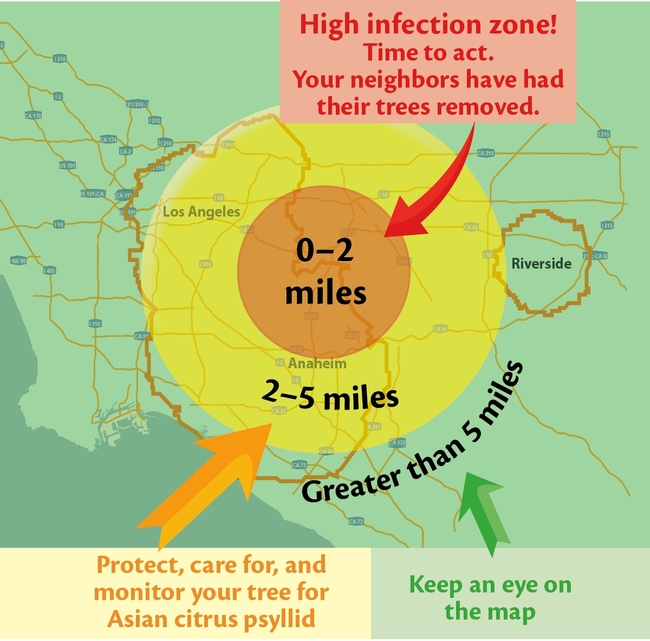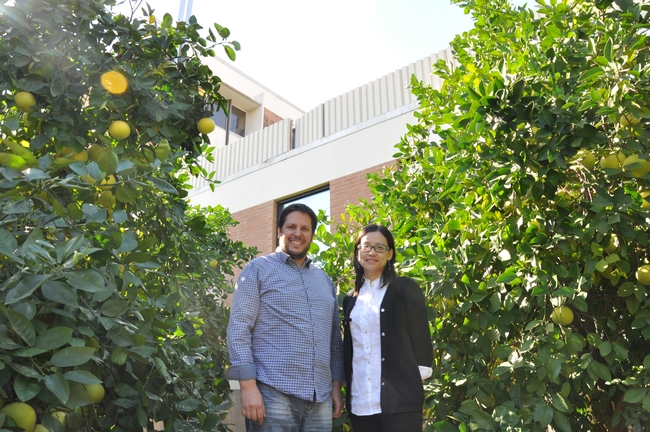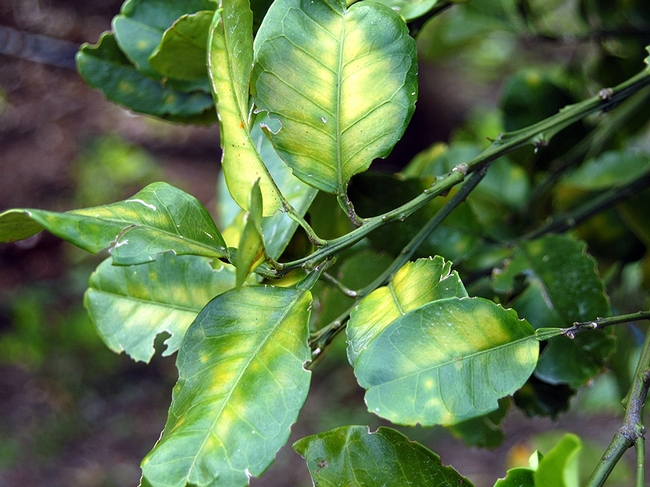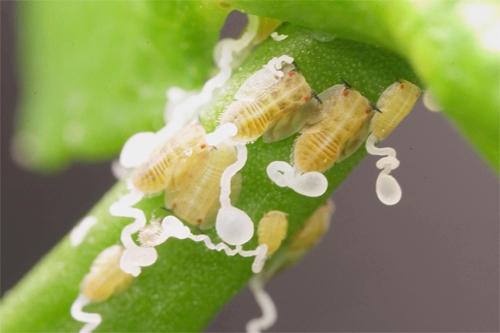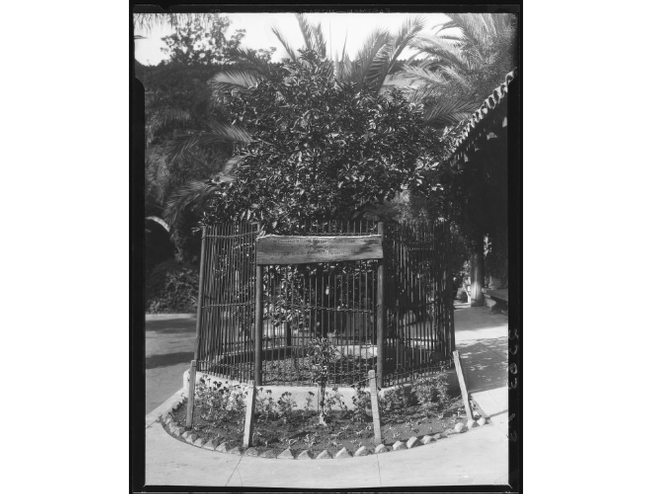Posts Tagged: asian citrus psyllid
Consult UC ANR's map to see how close you live to citrus with HLB disease
UC Cooperative Extension developed an online interactive map that allows Californians to see how close they live to citrus trees infected with huanglongbing disease, reported Jeanette Marantos in the Los Angeles Times. This information is critical for the more than 60% of Californians who are growing their own backyard orange, grapefruit, mandarin, lime and other citrus trees.
Huanglongbing is an exotic citrus disease that kills every tree it infects. An exotic insect, the Asian citrus psyllid, spreads the disease from tree to tree. If the disease makes its way into California's commercial citrus production regions, it threatens the state's valuable and iconic citrus industry.
Go to http://ucanr.edu/hlbapp and type in your address. If you are inside the red circle — within two miles of a hot zone — UCCE suggests you remove your citrus trees and plant different types of fruit trees, such as peaches, pears, apples or figs, until researchers find a cure. In the yellow circle — within two to five miles of a hot zone — consider replacing your tree with a non-citrus fruit tree or protect your citrus trees. Find detailed information on home citrus management here https://ucanr.edu/sites/ACP/Homeowner_Options/
“When we first started this program back in 2012, I was encouraging Master Gardeners to teach homeowners how to treat their trees [to discourage psyllids, which are the insects that spread HLB],” she said, “but the complaint came back from the Master Gardeners, ‘I treat my trees but none of my neighbors do, so what's the point?'” said Beth Grafton-Cardwell, UC Cooperative Extension entomology specialist and director of the Lindcove Research and Extension Center in Exeter.
Grafton-Cardwell said the threat is serious. HLB disease devastated Florida's citrus industry when it hit in 2005, destroying half of its acreage and production, and pretty much eliminating residential citrus.
The battle against the psyllid in California is being helped by the introduction in 2011 of Tamarixia radiata, a parasitic wasp native to Pakistan, by UC Cooperative Extension biological control specialist Mark Hoddle and his entomologist wife Christina Hoddle.
"We've had psyllid here [in California] since 2008, but we still have a lot of oranges,” Hoddle said. “The disease hasn't swept through California the way it did through Florida, and I believe our biological control program is why. Psyllid populations have decreased by 70% to 80% since our first parasite release in 2011. We haven't wiped out HLB in citrus trees, but we have mitigated the risk.”
Deadly Citrus Greening Disease: A Better Lure for Asian Citrus Psyllids
If you like or grow citrus, you ought to be worried about the worldwide threat of the deadly citrus greening disease (Huanglongbing or HLB) caused by...
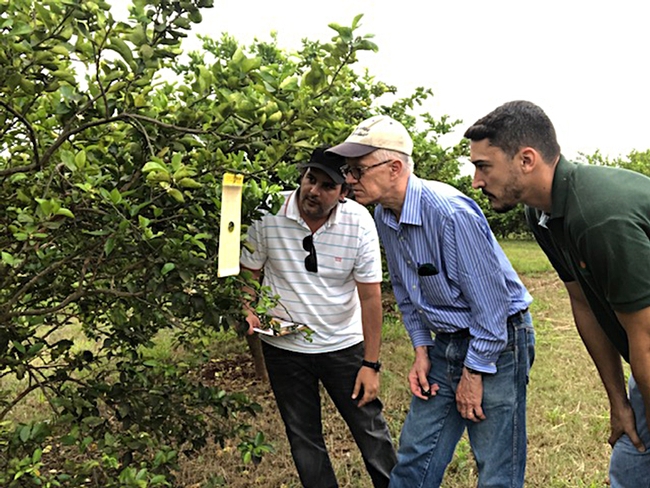
UC Davis chemical ecologist Walter Leal (center) examines a lure in Mogi Mirin, São Paulo on Brazil’s Independence Day (Sept. 7) with Haroldo Volpe (far right) and Renato de Freitas, both of Fundecitrus.
Screen installed over the 'parent navel' in Riverside to protect it from disease
City of Riverside staff draped a synthetic screen on a steel frame to encompass the 'parent navel' orange tree at the corner of Arlington and Magnolia avenues in Riverside to protect it from Asian citrus psyllids that spread huanglongbing disease, reported Ryan Hagen in the Riverside Press-Enterprise. Huanglongbing (HLB) is a devastating bacterial disease of citrus that is starting to spread rapidly in urban areas of Southern California.
The newly covered tree is valued for its status as an early ancestor of all Washington navel orange trees.
UC Cooperative Extension specialist Georgios Vidalakis, the UC Presidential Researcher for Sustainable Citrus Clonal Protection, was on site when the tree was enclosed within the new cover.
“This one will buy us a few years so the city can design a more elegant structure like you see in arboretums — maybe a wood hexagonal pavilion that will be aesthetically more pleasant,” Vidalakis said. “Unless in the next few years we find a solution.”
UC Agriculture and Natural Resources specialists and advisors are working with the citrus industry, USDA and CDFA to control ACP populations and keep HLB contained while researchers search for a cure for the disease.
Huanglongbing is a growing threat to California’s citrus industry
Asian citrus psyllid was first identified in California in 2008, and has been found from San Diego and Imperial counties in the south, all the way to Sacramento County in the north. See a map of Asian citrus psyllid and huanglongbing distribution in California.
UC Agriculture and Natural Resources specialists and advisors are working with the citrus industry, USDA and CDFA to control ACP populations and keep HLB contained while researchers search for a cure for the disease.
In order to find and remove infected trees before ACP can spread the disease to other trees, UC scientists are focusing research on early HLB detection technologies (EDTs). When infections first start, the bacteria are in just a few leaves. If the sampler doesn't collect those leaves, the disease can be missed. It can take one to two years for the bacteria to distribute itself throughout the tree so this sampling error doesn't occur.
Early detection technologies use whole tree responses to early infections. For example, Carolyn Slupsky, food science and technology professor at UC Davis, measures changes in tree metabolism (its day-to-day chemical function) when it becomes infected. Every leaf on the tree is connected to the tree's metabolism, so it doesn't matter which leaf is collected. This type of test can detect an infected tree within weeks or months after infection instead of years.
Scientists are also studying ways to modify ACP so the insects are unable to spread HLB, and studying the use of conventional breeding, genome editing or genetic engineering to develop disease-resistant citrus. Read summaries of the research here.
Keeping Asian citrus psyllid and huanglongbing disease at bay depends in large part on the active involvement of commercial citrus growers and California residents who have citrus trees in their home landscapes. The UC ANR Asian Citrus Psyllid Distribution and Management website provides detailed guidelines for growers and residents to monitor for Asian citrus psyllid and huanglongbing, and learn about options for reducing psyllid populations and responding to the disease if it's in your area.
View a four-minute video that shows how to monitor for ACP presence in residential citrus:
Riverside Washington Navel gets additional protection
The city of Riverside is taking steps to protect a 143-year-old Washington Navel orange tree - the tree that parented most navel oranges alive today, reported the Riverside Press-Enterprise.
According to legend, the seedless and sweet Washington navel was an accidental mutant that appeared on the grounds of a Brazil monastery in the early 1800s. Tree clones were sent to USDA in Washington, D.C., and from there acquired by Eliza Tibbets, who tended the trees at her home in Riverside.
This month, city workers removed two trees that were planted near the iconic navel orange - a Marsh Grapefruit and another navel, which was planted in the 1940s and doesn't have the historical value. They have built a steel structure over the Washington Navel to support a transparent screen that will keep out Asian citrus psyllid, an invasive pest that spreads the devastating huanglongbing virus in citrus.
The measures to protect the tree were planned by a team that includes scientists from UC Riverside, the Citrus Research Board and the USDA, the article said.
For more information on the photo above, see visit this UCLA Library page.


